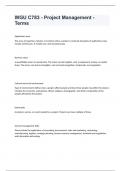Exam (elaborations)
WGU C783 - Project Management - Terms well answered
- Course
- WGU C783
- Institution
- Western Governors University
WGU C783 - Project Management - TermsApplication areas The areas of expertise, industry, or function where a project is centered. Examples of application areas include architecture, IT, health care, and manufacturing. Business value A quantifiable return on investment. The return can be tang...
[Show more]



